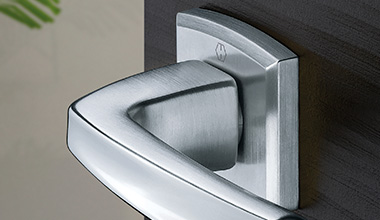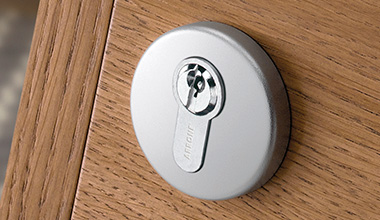BS EN 12209

BS EN 12209:2016 – Mechanically operated locks, latches and locking plates
The ARRONE range of locks is manufactured to the highest engineering standards and designed to offer a high price/performance ratio. They have been successfully type tested to all the requirements of BS EN 12209:2016. The classification achieved is given for each lock separately.
Digit 1 – Category of use
Three categories of use are identified:
Grade 1: low frequency of use by people with a high incentive to exercise care and a small chance of misuse, e.g. internal residential doors
Grade 2: medium frequency of use by people with some incentive to exercise care but where there is some chance of misuse, e.g. internal office doors
Grade 3: high frequency of use by public or others with little incentive to exercise care and with a high chance of misuse, e.g. public doors
Digit 2 – Durability
Twelve grades are identified with minimum figures for deadbolt and snib operation, and latch bolt operation with and without side load, as shown. The side load is applied to the latch bolt when it is being withdrawn.
|
↑ No. of operations |
Increasing side load → |
||||
| Grade C | Grade H | Grade M | Grade S | Grade X | |
| Grade B | Grade G | Grade L | Grade R | Grade W | |
| Grade A | Grade F | ||||
Digit 3 – Door mass and closing force
Nine grades are identified with maximum figures for closing force at various door masses as shown.
Note: closing force is from a standing start, i.e. fully extended latch bolt in contact with striking plate at start of test.
| Maximum closing force | up to 100 kg | Door mass up to 200 kg |
above 200 kg |
| 15 N | grade 7 | grade 8 | grade 9 |
| 25 N | grade 4 | grade 5 | grade 6 |
| 50 N | grade 1 | grade 2 | grade 3 |
Digit 4 – Fire resistance
Two grades are identified:
Grade 0: not approved for use on fire/smoke door assemblies
Grade 1: suitable for use on fire/smoke door assemblies tested to BS EN 1634-1 etc.
Digit 5 – Safety
No requirement, but note: A lock or latch conforming to this standard can, at the same time, also be part of an exit device conforming to BS EN 179:2008 or BS EN 1125:2008.
Digit 6 – Corrosion resistance
Eight grades are identified with neutral salt-spray (NSS) corrosion resistance grades from BS EN 1670:2007, with and without temperature resistance as shown:
| Corrision resistance (NSS) | Temperature resistance No requirement |
Temperature resistance -20 ºC to +80 ºC |
| 240 hours | grade D | grade G |
| 96 hours | grade C | grade F |
| 48 hours | grade B | grade E |
| 24 hours | grade A | |
| No requirement | grade 0 |
Digit 7 – Security and drill resistance
Seven grades are identified with minimum figures for requirements relating to physical attack, with or without drilling of the lockcase, as shown:
| Increasing resistance to attack | No drilling requirement | Drilling requirement |
| grade 6 | grade 7 | |
| grade 4 | grade 5 | |
| grade 3 | ||
| grade 2 | ||
| grade 1 |
Digit 8 – Field of door application
Fifteen grades are identified for differing applications – hinged or sliding doors with rim or mortice locks with either keyless egress from inside or key locking from both sides. The grading determines which application is appropriate. In addition, there is a requirement that lock/latch should not be removable from outside or, for grades K to R, from inside using “standard” tools. Grades H and P require support for the lockcase when installed.
Digit 9 – Type of key operation and locking
Nine grades are identified for differing types of key operation. The grading determines how the lock is assessed for deadlocking requirement as shown. In addition, there is a maximum key torque operating requirement of 1.5 Nm and a minimum key strength requirement of 2.5 Nm.
Grade 0: not applicable
Grade A: cylinder lock or latch; manually locking
Grade B: cylinder lock or latch; automatically locking
Grade C: cylinder lock or latch; manually locking with intermediate locking
Grade D: lever lock or latch; manually locking
Grade E: lever lock or latch; automatically locking
Grade F: lever lock or latch; manually locking with intermediate locking
Grade G: lock or latch without key operation; manually locking
Grade H: lock without key operation; automatically locking
Digit 10 – Type of spindle operation
Five grades are identified:
Grade 0: lock without follower
Grade 1: lock with sprung lever or knob
Grade 2: lock with light unsprung lever
Grade 3: lock with heavy unsprung lever
Grade 4: lock with manufacturer’s own specification furniture
Digit 11 – Key identification
Nine grades are identified relating to the number of differs and levers.
Grade 0 relates to a latch with no locking action:
|
↑ No. of differs |
No. of levers → |
||||||||
| grade H | |||||||||
| grade F | grade G | ||||||||
| grade D | grade E | ||||||||
| grade B | grade C | ||||||||
| grade A | |||||||||
| grade 0 | |||||||||
Sources:
Door and Hardware Federation (DHF) Best Practise Guide – Mechanically operated locks, latches and locking plates- BS EN 12209




